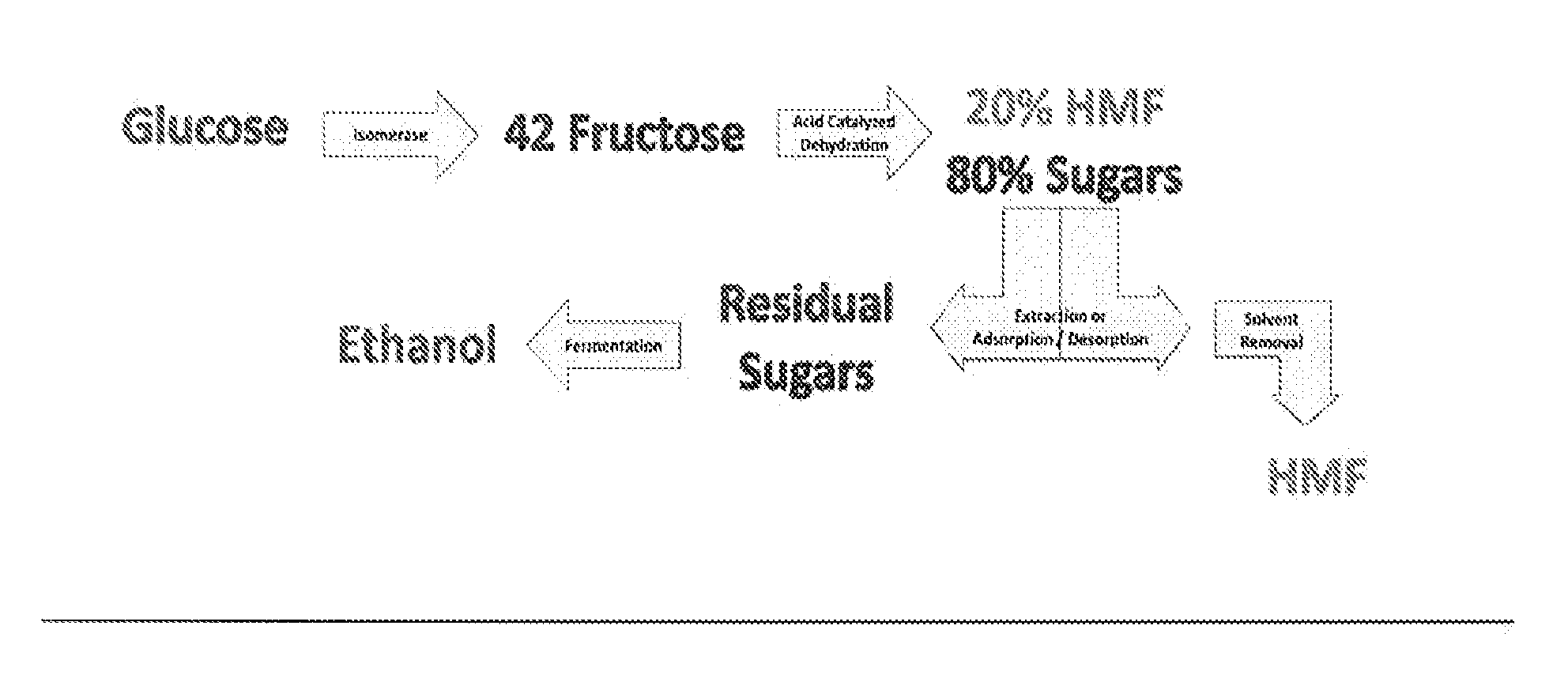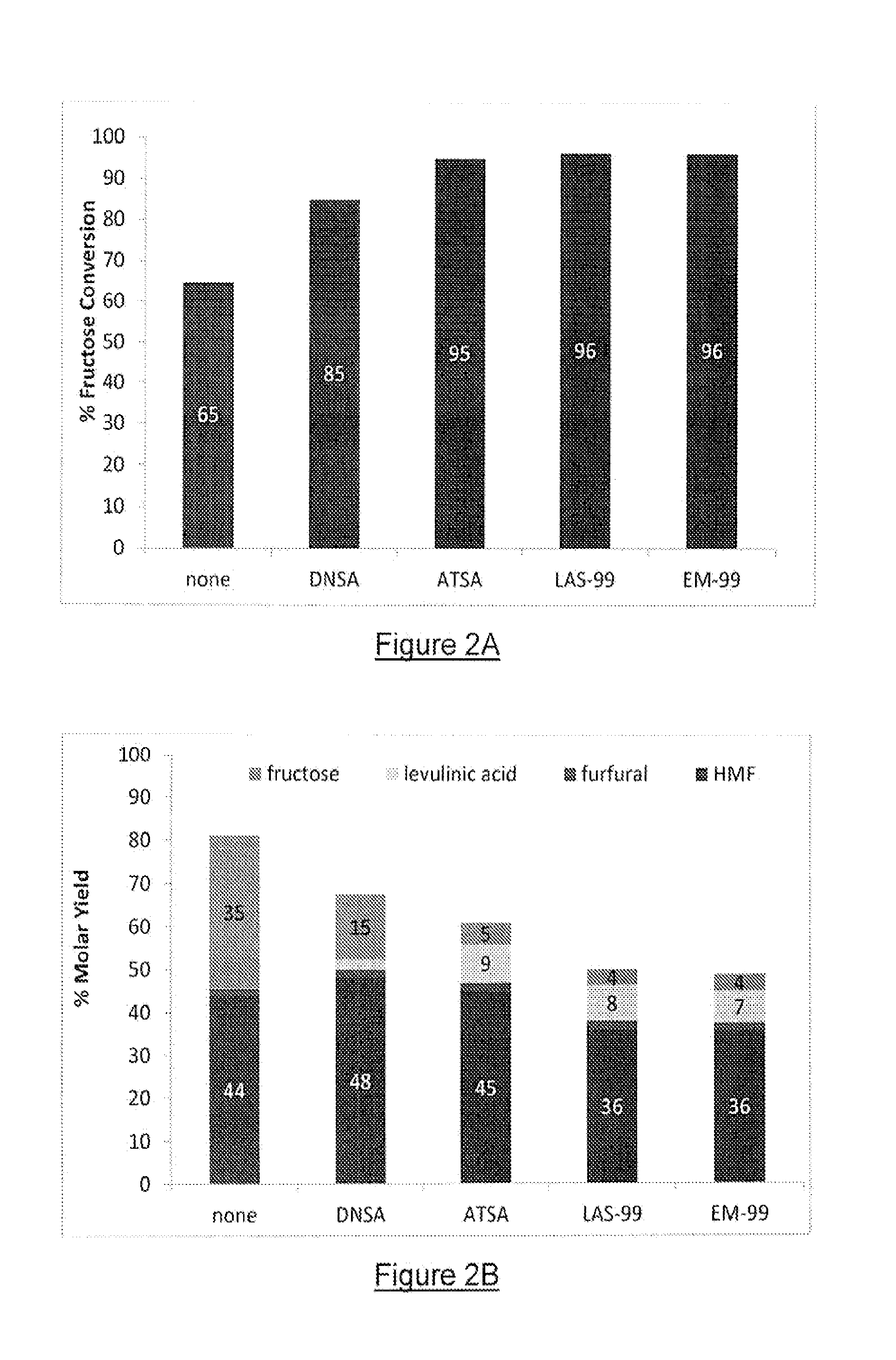Processes for making sugar and/or sugar alcohol dehydration products
a technology of dehydration products and sugar alcohols, which is applied in the field of dehydration products made from sugars and/or sugar alcohols, can solve the problems of increased humin formation, low selectivity and increase in polymer and humin formation under aqueous conditions, and further complications, etc., and achieves high sugar accountabilities, high conversion efficiency, and simplified separation and recovery of products.
- Summary
- Abstract
- Description
- Claims
- Application Information
AI Technical Summary
Benefits of technology
Problems solved by technology
Method used
Image
Examples
examples 1-4
[0076]For Examples 1-4, an initial series of batchwise carbohydrate dehydration reactions was performed at a bench scale, using a Parr multireactor system (Parr Instrument Company, Moline, Ill.). For each run, a 75 mL reaction chamber was charged with a crystalline fructose sugar solution (5 percent by weight, on a dry solids basis) and with a selected substituted sulfonic acid catalyst at a loading of 2 percent based on total sugars. The reaction mixture was then heated to 180 degrees Celsius over a period of 25 min with magnetic stirring at a controlled rate of about 850 rpm. After reaching 180 degrees, the reaction was continued for 30 minutes at that temperature, then the product was rapidly cooled to about 30 degrees Celsius or less by submerging the vessel into an ice water bath. Analysis of the samples was by HPLC. The results are shown in FIGS. 2A and 2B for percentage fructose conversion and molar percentage yield of HMF, respectively, and demonstrate that the substituted s...
examples 5-9
[0077]Using the same apparatus as used in Examples 1-4, a 75 mL reaction chamber was first charged with an acidic aqueous solution, containing a catalyst loading of 2 percent of a given one of the same substituted sulfonic acids as in Examples 1-4 or of an Aristonic® acid 9800 grade catalyst (in one instance, a “no catalyst” control was used, just as in Examples 1-4). The acidic aqueous solution was then heated to 180 degrees Celsius over a period of 25 min with magnetic stirring at a controlled rate of about 850 rpm. After this, an HFCS 90 sugar solution (at about 20 to about 25 percent hexoses by weight, on a dry solids basis) was rapidly introduced into the preheated acidic aqueous solution by an Eldex high pressure pump (Eldex Laboratories, Inc, Napa, Calif.) over a period of about 120 sec. The reaction was continued for the various, much shorter reaction times indicated in FIGS. 3A and 3B, then the product was flowed through a cooling coil consisting of ⅛″ stainless steel tubin...
example 10
[0078]A more detailed compositional analysis was conducted of the dehydration product mixtures that resulted at various reaction times in Examples 5-9 using the Aristonic® acid 9800 grade catalyst. An analysis was also conducted on the product mixture resulting from use of the same catalyst and according to the same method of Examples 5-9, but with a longer, 16 minute reaction / residence time. These results are shown in FIG. 5A. For comparison, a series of tests were conducted in the same manner at various reaction times, but using an Aristonic® acid 9900 grade catalyst from the same manufacturer. The detailed compositional analyses of the product mixtures produced are shown in FIG. 5B, and demonstrate higher HMF yields and overall sugar accountabilities for the 9900 grade material as compared to the 9800 grade material.
PUM
| Property | Measurement | Unit |
|---|---|---|
| reaction temperature | aaaaa | aaaaa |
| temperature | aaaaa | aaaaa |
| pressure | aaaaa | aaaaa |
Abstract
Description
Claims
Application Information
 Login to View More
Login to View More - R&D
- Intellectual Property
- Life Sciences
- Materials
- Tech Scout
- Unparalleled Data Quality
- Higher Quality Content
- 60% Fewer Hallucinations
Browse by: Latest US Patents, China's latest patents, Technical Efficacy Thesaurus, Application Domain, Technology Topic, Popular Technical Reports.
© 2025 PatSnap. All rights reserved.Legal|Privacy policy|Modern Slavery Act Transparency Statement|Sitemap|About US| Contact US: help@patsnap.com



